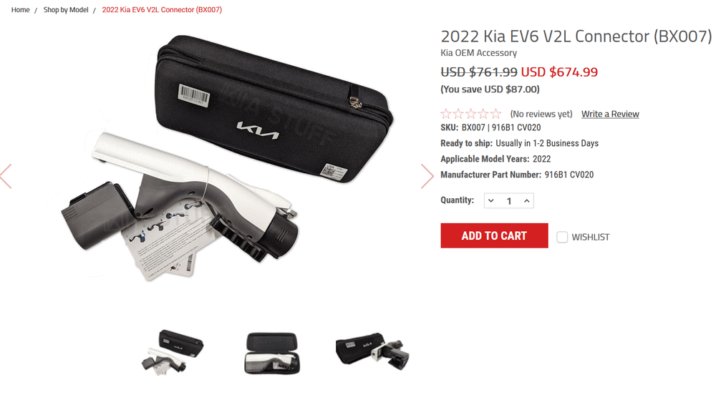V2L is cool, but it’s not a real option for home backup

Vehicle-to-Load (V2L), as demonstrated in the video below, is seriously cool. If you have an EV that does it, there will be scenarios where it could be awesome; like saving your food during a power outage. I wanted to start with that, so that it doesn’t get lost in what I’m going to say next. As cool as V2L is, I would not count on it as a home power backup during a power outage, and I would not recommend it to anyone for that purpose either.
Before getting to limitations it’s critical to understand what V2L is. In a nutshell, you plug this adapter into the car (yes, that price is bonkers), and you get one 16A outlet to plug stuff into, so ~1.9kW of peak load. Sustained load should be limited to 80% of that. That might seem like a lot, or a little, and it is both depending what you are plugging into it. That should be more than enough to run a campsite. But, once we start talking about large appliances, then it rapidly shifts the other way. The fellow in the video demonstrates that he’s able to run a fridge and a deep freeze off it. Also, while making accommodations (i.e. unplugging stuff) to also cook things for dinner. So in a pinch, with an educated user, it obviously can work as long as you don’t need HVAC or sump pumps.
I’ve mentioned before that we installed a natural gas (NG) generator at our house. Our main use case for installing it was to keep the sump pumps (yes, pumps) running if there were a power outage during a storm (it has happened since, so Yay!). The car might be able to power one of our 3/4HP pumps (I’d have to check the peak load as it kicks on), but it’s highly unlikely to be able to handle both of them. The other thing is what about HVAC? If you have NG heat, you still need electricity to make that work. You can wire the furnace so that it plugs into a standard wall receptacle, and if yours is, then it’s technically possible to run it off the car. Our furnace pulls around ~1kW as it starts up, and then about ~550W to run the blower. So that works, but it would be very tight to leave it plugged in with any other large appliance on the same circuit. Which is why it has it’s own in our house.
If you have electric heat, umm… good luck with that.
So what about something like what Ford is doing with the F150 Lightening. That can supply plenty of power (~19.2kW) to the house? In the right circumstances that can absolutely work. You don’t need to explain to your family that before making dinner, the fridge and furnace need to be unplugged, and then plugged back in so the food doesn’t rot and pipes don’t freez, but someone has to stay awake so that if they turn on at the same time, the system can be brought back online like you would running it off the Kia/Hyundai solution… But, it doesn’t solve the car-needs-to-be-home problem. What happens if the power goes out during a storm and you’re not home, or you’re asleep and didn’t jump through the hoops? It’s very likely that you’ll be coming back (or waking up) to a mess. Whether that’s spoiled food, or mold in the basement, it’s going to suck. And that’s even before we get to the cost of Ford’s solution…
Now, again, it’s great that both of these options exist. But it’s key to understand the nuance associated with relying on either of them as a power-outage solution. Sure, they might work. But the viability of either is going to depend significantly on your technical acumen, tolerance for risk, and how cool your family is with both.
This is the video I mentioned before. There’s actually not much too it; just a lot of B-roll to get to the place where you need to stay within the highly restrictive 1.9kW peak that the car’s inverter can provide. He seems to think it is way more useful than it is, but that’s probably because the requirements are so narrow in scope that it’s not realistic for the reasons I mentioned above.

Thank you so much for sharing such useful information over here with us